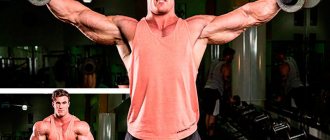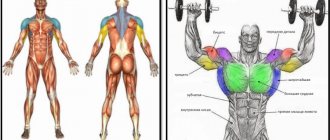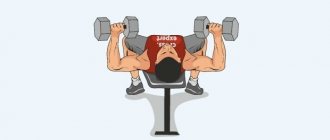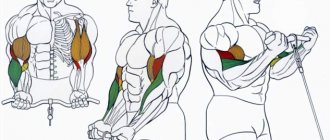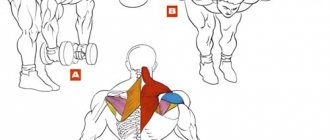Broad shoulders in men have always been associated with strength. It is beautiful and broad shoulders that create a sporty and masculine look. The basis of the shoulders is made up of the deltoid muscles (anterior, middle and posterior bundle), which are located along the entire shoulder joint. To increase the volume of these muscles, you will have to spend some time and effort. One of the most effective exercises for increasing and strengthening the deltoid muscles is the standing dumbbell fly. To achieve maximum results from this exercise, you need to carefully approach the technique and take into account all the nuances.
- The main essence and rules for performing the exercise
- What muscles will be used during the fly exercise?
- Basic rules when performing the exercise
- Benefits of exercise
- Basic technique for performing the “Divorce” exercise with both hands
- The nuances of performing dumbbell swings to the sides while standing, video
- Basic technique for performing the “Fly” exercise with one hand
- Don't make these mistakes!
Working muscles when raising dumbbells to the sides
Such exercises operate in an isolated format. Raising dumbbells to the sides, which muscles are involved: only the middle and lateral deltoids work. This is what obliges the athlete to be attentive to his health and select weight based on the degree of muscle readiness.
Attention! Under no circumstances should you lift heavy weights. The increase in load should be gradual.
There are several rules that will help protect muscles from injury.
Rules:
- if you plan to press standing or sitting on the day of shoulder training, then you should not attach the barbell to your chest;
- if the bench press is not expected, but there will be abduction and lifting, then on this day it is worth working out the triceps.
Vulnerability of the shoulders
Anyone who has injured the deltoid muscle at least once in their life knows why this can happen. Moreover, there are cases when a person has warmed up enough and smoothly approached the working weight (for example, in a bench press). And during one of the repetitions I felt pain.
The deltoids are not very well positioned. When moving, the tendons rub against the bones, gradually erasing their surface. This leads to inflammation of their membranes. Tears occur due to incorrect technique, poor warm-up and other violations. But the inflammation is due to such characteristics of the shoulders.
Standing dumbbell raises are also a relatively traumatic element of shoulder work. Therefore, technology is put at the forefront.
Another reason that the deltoids are most often injured is their overload.
When exercising in the gym, the deltas work during all barbell and dumbbell presses and fly-ups at all angles. Therefore, when you pump your chest, your shoulders work. You pump the triceps with the base - they do the same. You do push-ups or pull-ups - and then your shoulders come into play. In the first case, of course, more. When pulling up, the posterior deltoids are involved. In any case, spreading your hands on such days is not the best idea.
Why Shoulders Are Often Injured?
The exercise itself is not that dangerous. What leads to injury is that the athlete performs the exercise thoughtlessly and puts a lot of aggression into the movements. Everyone wants the process of creating a beautiful shape to be quick, but it doesn’t happen. That is why swinging dumbbells to the sides while standing should be performed as calmly as possible.
There's a daily load on your shoulders. Just because you're sitting at work doesn't mean they're not stressed. And if you also carry heavy packages from the store home, then this is an additional load that negatively affects the shoulder girdle.
Most often, serious injuries are sustained by beginners who decide to start going to the gym after work. Without warming up, they begin to bench press and perform dumbbell swings to the side. They want beautiful shoulders, but they end up with sprains. The joints become overloaded and this leads to serious injuries.
For beginners, no more than 2-3 shoulder exercises are ideal.
The note! It is important to remember that such exercises should only be performed under the supervision of a trainer. There is no need to overestimate your capabilities.
You need to start the exercise with a minimum weight of 2-3 kilograms.
A shoulder injury is always a severe inflammation. It is never localized. The inflammatory process affects the entire muscle bundle. If injury occurs, you should not self-medicate. Go to the doctor, tell them what exercises you did, and treat your shoulders.
Technique for performing dilutions
Before you start doing the exercises, you need to know what the exercise is aimed at. Swinging dumbbells through the sides is necessary in order to strengthen the lateral deltoids. If you do the exercise with errors, this will lead to the fact that the main emphasis will go to the front bundle.
Important!
Before you begin the exercise, warm up the muscles and joints of the shoulder girdle well. The longer you reheat, the better.
Dumbbell lateral raises – technique:
- Stand in front of the mirror. Take the minimum weight - no more than 4 kilograms.
- Straighten your back, straighten your shoulders. The legs must be placed at the width of the pelvic bones.
- Look straight into the mirror. The arms are slightly bent at the elbow joint. Throughout the entire exercise, the angle of flexion at the elbow should be static. We lower our arms to our sides. The brushes extend slightly forward beyond the border of the body.
- We take the dumbbells so that the palms look straight towards the body.
- We move our arms so that the elbows look back and up. The arms are raised until they are parallel to the floor.
- It is necessary to stay in the maximum lifting position for no more than 2 seconds.
At the beginning of any workout, remember that you need to start training with a minimum weight. This allows you to better warm up your muscles and avoid serious injury.
Important! No sudden movements or aggression. If you think that this will make you look more impressive, then remember that the desire to demonstrate masculinity will lead to injury, which means that the road to the gym will be closed for a long time.
Swings with one dumbbell
Dumbbell lateral raises while standing can be done even if only one dumbbell with the required weight is free in the gym. The exercises are performed with the same technique, but at the same time it is necessary to hold on to a support that will be static. This will avoid unnecessary vibration of the body, and therefore minimize the risk of possible injury.
In addition, this exercise will be of interest to those who are faced with muscle imbalance.
Important! No side bending. This can lead to pinched nerve endings.
Execution rules:
- The stance is exactly the same as when performing standard swings with two dumbbells.
- The weight for the arm is selected with the help of a trainer. If you are faced with muscle imbalance, do not be lazy to contact a specialist. This will help avoid injury and achieve a symmetrical result.
Lateral raises of dumbbells - basic mistakes
It's not just newbies who make mistakes. Professionals can also make mistakes. But, not from ignorance, but because for a split second they lost control. Unfortunately, this happens.
Standard errors:
- The desire to gain relief as quickly as possible. This leads to the athlete taking on weight that is too heavy for himself. As a result, the exercise is not performed correctly. This leads to severe injury to the muscles of the shoulder girdle.
- Extra movements. Sometimes beginners reflexively make unnecessary movements: they roll from heel to toe or change the position of their legs. You can’t do this, it can also lead to injury. The body must be static.
- Incorrect trajectory of performing dumbbell lateral raises while standing. Throwing a projectile towards the head is a direct path to injury and inflammation of the ligaments.
- Error in setting the home position. Sometimes beginners are faced with such a problem as positioning the body, namely the back, with a tilt back. Under no circumstances should you do this! This is dangerous not only for the muscles of the shoulder girdle, but also for the spine. For this reason, we urge beginners to contact professional trainers who will help you set up the exercise technique correctly.
- Uneven lifting of dumbbells on the left and right. This happens if the spine is curved. In this situation, we recommend consulting a doctor, wearing a special corset, and performing the exercise with only one arm at a time.
- Incorrect pelvic position. Beginners also suffer from this: they slightly bend the hip joint. This results in the load being distributed incorrectly.
- Hip flexion due to fatigue. If you feel too tired, it is better to stop doing the exercise altogether rather than putting weight on the hip joint, thereby making the task easier for yourself.
- Involvement of other muscles in work. This also happens because the athlete is tired. Tired? Rest. To practice reflex muscle isolation, contact a trainer. This will help you get a better feel for the area you are working on.
As you can see, there are a lot of errors. To hone a technique to perfection, you need patience and desire. It is important to be aware that any incorrect movement can lead to injury!
Expert opinion
Professional instructors note that lifting dumbbells from a standing position is a rather traumatic exercise. Therefore, at the initial stage of training, lifting should be done in the presence of an experienced trainer and with light weights. It is better to start performing with 8-10 repetitions in a three-time set. The main thing is to hone the right technique!
0 11
Did you like the article? Share with friends:
We recommend reading:
Benefits of Smith Machine Squats
Squats with a barbell on the chest and on hands
Hack squats with a barbell - technique
Plyometric push-ups - technique and variations
Front squats with barbell
How to pump up your butt in a week at home?
Features of the exercise
Raising arms with dumbbells while standing to the sides is an exercise that has its own characteristics. Taking these features into account and following the rules will help you achieve the necessary relief while maintaining healthy joints.
Peculiarities:
- Wiring is performed only with the weight that is right for you. How do you know what weight you need? Go to the trainer. There is no need to select the weight at random. Most beginners start working with this exercise with 2-3 kilograms.
- If you take too little weight, nothing will change. If you take too much weight, the load will most likely transfer to the elbow joint. In this situation, the execution technique suffers greatly. Too much weight will result in injury.
- If you raise your arms too high, the trapezius muscles will be involved in the work. Did you have plans to train this muscle group? Fine. If not, then make sure that your arms with dumbbells are raised parallel to the floor.
- You need to raise your arms while exhaling. We return to the starting position while inhaling.
- When performing the last repetition, hold your arms parallel to the floor for 10-15 seconds. This will help strengthen your muscles. and consolidate the effect of the training.
- You need to lower your arms smoothly, without sudden movements or aggressive throws.
To perform the exercise correctly, knowledge and skill are required. At first, contact your coach for help. This way you will learn more nuances about performing the exercise and protect your ligaments and joints from injury. In addition, remember that good results cannot be achieved if you do not monitor your diet.
5/5 — (24 votes)
Share link:
Mistake 2: Lowering the projectile too low
The best way to develop your middle delts is to keep them under load throughout the entire set. If you drop your arms too low so that they hang at your sides or dangle in front of you at hip level, you are taking the pressure off your deltoids entirely.
Moreover, when you raise your arms from a position of full extension, the supraspinatus muscle (the rotator cuff muscle) initiates the movement, and the middle deltoids are involved later. This means that the first few degrees of the raise do not work the target muscles.
The best option is to stop the movement when the hands are at a distance of 5-10 cm from the body. This will make the subsequent climb up a little more difficult, but that’s what you’re trying to achieve, isn’t it? If you want to work the supraspinatus muscle a little, then feel free to lower your arms all the way. But then, when lifting the projectile, be careful. Don't lift too much weight and don't jerk - either one or the other can result in injury.
